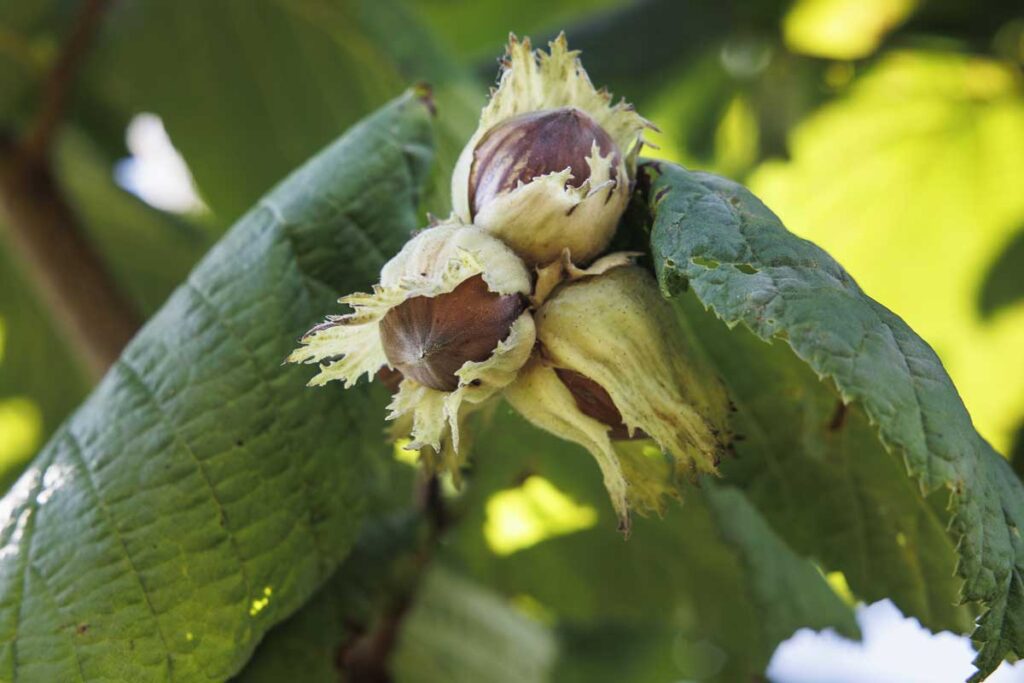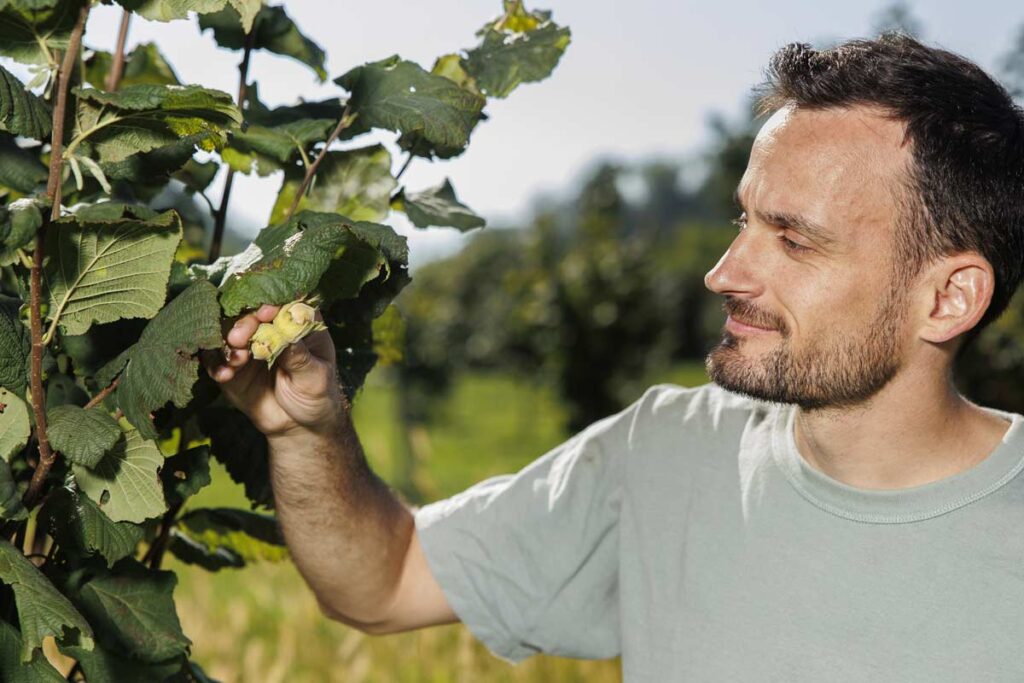Swiss hazelnuts on the rise: a look back at a pioneering project for more biodiversity and sustainable nutrition

90% of the hazelnuts consumed in Switzerland come from Turkey. Yet the hazelnut is actually native to Switzerland! Since 2022, Crowd Container has been working with ecologist and farmer Stefan Gerber on a pioneering project: the first large-scale hazelnut plantation in the canton of Zurich. After three years, we take stock and summarize exciting findings from our project.
A variety garden for the future
At the heart of the project is a unique hazelnut variety garden, which has now grown to an impressive 72 different varieties. What began as a collection of around 50 varieties has been systematically expanded with new varieties from Oregon State University and hybrid plants. This treasure trove of genetic diversity also provides valuable insights for Swiss hazelnut cultivation.
Stefan Gerber meticulously documented the flowering times of the various hazelnut varieties over a period of three years - a first for Switzerland. These observations are worth their weight in gold, as the male and female flowering phases of different varieties must overlap for successful pollination. What works in Italy or Turkey does not necessarily work in our climate! An exciting example: the classic pollinator pair "Tonda Romana" and "Tonda di Giffoni" does not work in Switzerland. Here, the female flower of "Tonda di Giffoni" fades before the male flower of "Tonda Romana" even opens. Such findings are crucial for the success of future Swiss hazelnut orchards.
When biodiversity meets agriculture
The hazelnut orchard in Mettmenstetten is much more than just a production site - it is a living ecosystem. Professional monitoring by Ö+L GmbH showed that, compared to two other fruit and berry farms in the region, the hazelnut orchard performed best in terms of the number and species of wild bees.
The variety of biodiversity measures implemented is impressive:
- Wild hedges with wild roses, cornelian cherries and sea buckthorn
- Weasel castles as shelter for the little hunters
- Beneficial insect strips between the rows of hazelnuts
- Creation of open ground areas for specialized species
- Nesting boxes for various bird species
The success can be seen and heard: A total of 49 bird species were observed in and around the site - including the now rare red-backed shrike and even a hoopoe that stopped off on its migration. The nesting boxes installed were already fully occupied by great tits, blue tits and tree sparrows in the first year.
Particularly pleasing: the mouse population remained at a low level thanks to natural enemies such as kestrels and weasels - proof that biological plant protection works!

The soil as a foundation
The three-year project phase impressively demonstrated how crucial healthy soil is for the success of a tree culture. In one of the plots, which had previously served as a cow pasture with individual standard fruit trees for over 30 years and had never been plowed, the hazelnut trees developed magnificently.
The situation was different in the plot that had previously been used for arable farming with annual plowing. Here, the initial condition was suboptimal: little humus and a lack of nutrients. Through targeted management with clover mixtures, generous applications of woodchips and composted chicken manure, we were able to gradually improve soil fertility.
The message is clear: while the nutrient supply can be improved relatively quickly, building up humus and biological activity takes time and patience. Time and patience, which are essential - because soil health has an even greater impact on plant health in tree crops than in arable crops.
How climate-friendly are Swiss hazelnuts?
Together with the myclimate foundation, we have drawn up a comprehensive life cycle assessment that compares Swiss cultivation with production in Italy and Turkey. The results are complex and reveal interesting nuances:
- Cultivation itself is responsible for the majority of the environmental impact: 79% of greenhouse gas emissions and as much as 95% of the total environmental impact are attributable to the cultivation phase.
- The absolute environmental impact of the Mettmenstetten plant is the lowest of the production sites compared. However, Italy scores slightly better per kilogram of hazelnuts - mainly due to the higher yields per hectare achieved there.
- An interesting aspect of Swiss production: the environmental impact referred to as "direct impact" (i.e. emissions directly on the plantation) is comparatively high in Mettmenstetten. The reason for this lies in the calculation: the average Swiss compost mix with its relatively high heavy metal load was used as the database value for the life cycle assessment - although Stefan Gerber only uses organic compost, whose actual environmental impact is probably lower.
- A key positive aspect: hazelnut cultivation can store considerable amounts of CO₂ in the soil: around 3.66 kg of CO₂ equivalents per kilogram of hazelnuts harvested. However, this CO₂ sequestration is only sustainable if the area is used as a hazelnut plantation in the long term.
The results of this life cycle assessment are an important starting point, but not the end of the story. Increasing yields (when the plantation is in full production) and optimizing the use of compost should further reduce the environmental impact per kilogram of hazelnuts.

Community involvement and media response
The active involvement of the community was a major success of the project. During several volunteer missions, volunteers lent a hand, planted trees, distributed wood chips and installed nesting boxes. In particular, the cooperation with the SwissRe Foundation as part of its "community days" enabled us to get even more people interested in regenerative agriculture. The three public tours of the site were met with great interest from a wide range of stakeholders and generated considerable media coverage - from the local Affolter Anzeiger to the BauernZeitung and Schweizer Bauer to the SonntagsZeitung and a detailed report in BioTerra magazine.
What remains and what happens next?
After three intensive project years, we can proudly say that we have laid the foundations for a new, resilient tree culture in Switzerland. The greater the genetic diversity within a crop, the greater its adaptability and resilience to the challenges of climate change. The first Swiss hazelnuts have already been harvested and marketed via crowd containers. And the positive ecological effects will continue to increase in the coming years - nature needs time, but rewards patience.
In the future, we plan to share the knowledge we have gained with interested farmers in an even more targeted manner. Thanks to the systematic documentation of flowering times, we can now make well-founded recommendations for variety constellations that work optimally in Switzerland. This enables other pioneers to enter this promising crop. In the long term, we see great potential for the expansion of Swiss hazelnut production - as a sustainable contribution to a climate-friendly and biodiversity-promoting food supply. The findings from this pioneering project provide the ideal basis for this.
Our conclusion: The combination of agricultural production and consistent biodiversity promotion is not only possible, but also creates a resilient system with multiple benefits for humans and nature. The Swiss hazelnut is well on the way to becoming a climate-friendly and biodiversity-promoting alternative to imported nuts.
Danke für diese innovative Idee und die damit verbundene Arbeit.
Schön ist diese Anlage anzusehen mit diesen Haselnusssträuchern und Bäumen.
Ich finde es wichtig und wertvoll wenn Pflanzen angebaut werden, die hier gut gedeihen und für Mensch und Tier von Nutzen sind. Die biologische Landwirtschaft sollte aus meiner Sicht gefördert werden. Sie leisten einen grossen Beitrag an unsere Umwelt und sind hoffentlich Vorbild für viele Menschen.
Super,das mit den Haselnüssen;
bin Haselnussmus süchtig👍🏻
Die Ökobilanz wird noch viel besser,wenn wir uns kalifornische
Mandeln abgewöhnen . Mir hilft
Haselmus auch gegen Zuckerschoki !
Merci vielmol
Spannender Beitrag 🙏